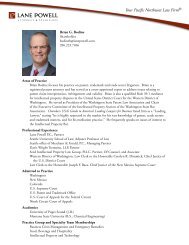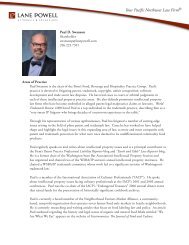portland's unreinforced masonry apartment buildings
portland's unreinforced masonry apartment buildings
portland's unreinforced masonry apartment buildings
You also want an ePaper? Increase the reach of your titles
YUMPU automatically turns print PDFs into web optimized ePapers that Google loves.
38 PORTLAND’S UNREINFORCED MASONRY APARTMENT BUILDINGS: A THREATENED SPECIES?<br />
cially “close in,” represent a key component of the city’s historic fabric, making an aesthetic<br />
and architectural contribution to the city.<br />
FEASIBILITY AND COST EFFECTIVENESS OF SEISMIC RETROFITTING OF URMS<br />
Since URM <strong>buildings</strong> are vulnerable to substantial damage in a major earthquake, one<br />
might well wonder whether it is technically possible to seismically retrofit them and, if<br />
so, whether such a retrofit is cost effective. The short answer is that a seismic retrofit is<br />
feasible, but expensive.<br />
The feasibility of seismically retrofitting a URM building has been established by several<br />
studies of the performance of seismically retrofitted URMs in specific earthquakes.<br />
In 1981, the City of Los Angeles adopted an ordinance mandating the seismic upgrading<br />
or demolition of approximately 14,000 URM <strong>buildings</strong>. By the time of the 1994 Northridge<br />
Earthquake (M 6.7), most URM <strong>buildings</strong> in L.A. had been seismically retrofitted, not to the<br />
seismic standards for a new building, but with the goal of bringing the URM <strong>buildings</strong> to<br />
a “reasonable level of safety.” [Analogous to what the author calls “Basic Life Safety.”] For<br />
example Reitherman and Perry (2009), citing California Seismic Safety Commission (2004),<br />
explain:<br />
As would be expected, unretrofitted URM <strong>buildings</strong> performed worse, in general, than<br />
both reinforced <strong>masonry</strong> <strong>buildings</strong> and retrofitted URM <strong>buildings</strong> . . . The performance of<br />
<strong>buildings</strong> retrofitted to the [“reasonable . . . safety”] standard . . . was generally in line with<br />
that criterion . . . .<br />
In the 2003 San Simeon Earthquake (M 6.5), the seismic retrofitting of URM’s was again<br />
tested. The nearby town of Paso Robles was severely impacted:<br />
Of 53 <strong>unreinforced</strong> <strong>masonry</strong> <strong>buildings</strong> in Paso Robles, the nearest affected city, none of<br />
the nine [0 of 9] that had been retrofitted experienced major damage. Many of the others<br />
were damaged so extensively they were subsequently demolished.”<br />
As to cost, in general, it is prohibitively expensive to bring an URM brick <strong>apartment</strong><br />
building up to the current seismic standards for a newly constructed <strong>apartment</strong> building.<br />
Even a more limited seismic retrofit of an URM <strong>apartment</strong> costing (say) $20 per square foot<br />
would, for a 40,000 gross square foot <strong>apartment</strong> building, cost $800,000. With 3.8 million<br />
square feet of URM <strong>apartment</strong>s, the upgrades for the approximate 200 URM <strong>apartment</strong><br />
<strong>buildings</strong> in the City of Portland would cost by very rough estimate in excess of $75 million<br />
or over $14,000 a unit. For comparison, the average sale price of an <strong>apartment</strong> unit in<br />
Portland Metro area in the fourth quarter of 2009 was about $87,000 (Barry, 2010).<br />
THE HISTORIC FACTOR IN URM RETROFITTING<br />
The technical feasibility and monetary cost of a seismic upgrade are not the only factors to<br />
be considered. There is also the potential aesthetic cost, that is, the adverse impact of an<br />
insensitive seismic upgrade on historic and architectural values. Many of Portland’s historic<br />
<strong>apartment</strong> <strong>buildings</strong> are beautiful examples of early 20th Century American interior and<br />
exterior <strong>apartment</strong> architecture designed by some of Oregon’s leading early 20th Century<br />
architects, such as Ellis Lawrence (Belle Court Apts.), Whitehouse & Fouilhoux (705 Davis<br />
Apts./ now Condominium) and William Knighton (Trinity Place Apts.). These architectural
















